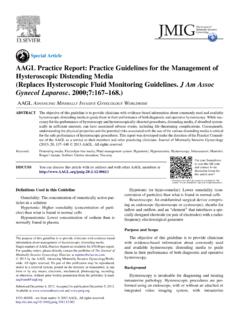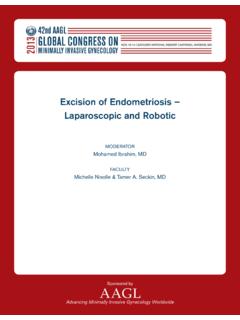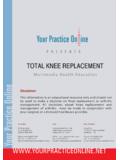Transcription of AAGL Practice Report: Practice Guidelines for the ...
1 Special ArticleAAGL Practice report : Practice Guidelines for the diagnosis andManagement of Submucous LeiomyomasAAGL:ADVANCINGMINIMALLYINVASIV EGYNECOLOGYWORLDWIDEABSTRACTS ubmucous leiomyomas or myomas are commonly encountered by gynecologists and specialists in reproductive endocrinol-ogy and infertility with patients presenting with 1 or a combination of symptoms that include heavy menstrual bleeding,infertility, and recurrent pregnancy loss. There exists a variety of interventions that include those performed under hystero-scopic, laparoscopic and laparotomic direction; an evolving spectrum of image guided procedures, and an expanding numberof pharmaceutical agents, each of which has value for the appropriately selected and counseled patient.
2 Identification of theideal approach requires the clinician to be intimately familiar with a given patient s history, including her desires with respectto fertility, as well as an appropriately detailed evaluation of the uterus with any one or a combination of a number of imagingtechniques, including hysteroscopy. This guideline has been developed following a systematic review of the evidence, toprovide guidance to the clinician caring for such patients, and to assist the clinical investigator in determining potential areasof research. Where high level evidence was lacking, but where a majority of opinion or consensus could be reached, theguideline development committee provided consensus recommendations as well.
3 Journal of Minimally Invasive Gynecology(2012) 19, 152 171 2012 aagl . All rights :Fibroid; Leiomyoma; Myoma; Submucous; Submucosal; Infertility; Pregnancy loss; Abortion; Menorrhagia; Abnormal uterine bleeding;Heavy menstrual bleeding; Myomectomy; Hysteroscopy; Uterine artery embolizationDISCUSSYou can discuss this article with its authors and with other aagl members your Smartphoneto scan this QR codeand connect to thediscussion forum forthis article now** Download a free QR Code scanner by searching for QRscanner in your smartphone s app store or app articles from MEDLINE CINAHL,Current Contents EMBASE, and the Cochrane Database ofsystematic reviews, published by December 31, 2010,were searched by use of the key words or combinations ofthe key words myoma, leiomyoma, myoma, submucous,submucosal, infertility, pregnancy loss, abortion, menorrha-gia.
4 Abnormal uterine bleeding, myomectomy, hysteroscopy,resection, vaporization, and metrorrhagia for all articlesrelated to submucous myomas. The quality of evidencewas rated with the criteria described in the report of theCanadian Task Force on the Periodic Health Examination(Fig. 1) [1].Uterine leiomyomas are tumors of the myometrium thathave a prevalence as high as 70% to 80% at age 50[2] butthat seems to vary with a number of factors including age,race, and, possibly geographic location. Prevalence insymptom-free women has been reported to be as low in Scandinavian women aged 33 to 40[3], whereasin the United States it is almost 40% in white patients andmore than 60% in women of African ancestry in the sameage group[2].
5 Leiomyomas are listed as the diagnosis forabout 39% of the approximately 600 000 hysterectomiesperformed each year in the United States[4]. These benigntumors, also calledmyomas,are usually asymptomatic, butthey have been associated with a number of clinical issuesincluding abnormal uterine bleeding (AUB) especiallyheavy menstrual bleeding (HMB), infertility, recurrent preg-nancy loss, and complaints related to the impact of the en-larged uterus on adjacent structures in the pelvis, whichare often referred to as bulk symptoms. Unfortunately,Single reprints of aagl Practice report are available for $ per quantity orders, please directly contact the publisher ofThe Journal ofMinimally Invasive Gynecology, Elsevier, -see front matter 2012 by the AAGLA dvancing MinimallyInvasive Gynecology Worldwide.
6 All rights reserved. No part of this publi-cation may be reproduced, stored in a retrieval system, posted on the Inter-net, or transmitted, in any form or by any means, electronic, mechanical,photocopying, recording, or otherwise, without prior written permissionfrom the August 25, 2011. Accepted for publication September 8, $ - see front matter 2012 aagl . All rights despite the prevalence and clinical impact of these le-sions, there is a dearth of high-quality research available toguide the clinician in the treatment of patients with is generally perceived that the symptoms of HMB,infertility, and recurrent pregnancy loss largely occur as a re-sult of lesions that distort the endometrial cavity that aretherefore adjacent to the endometrium and consequentlyreferred to assubmucous leiomyomas.
7 Whereas the develop-ment of hysteroscopically-directed surgical techniquesprovides the opportunity to remove such myomas transcervi-cally in a minimally invasive fashion, it is clear that thisapproach is not appropriate for all patients, making evalua-tion and selection extremely important features of clinicalcare. Selected individuals with submucous myomas maybe appropriate for a range of medical interventions, as wellas a spectrum of hysteroscopic, laparoscopic, or laparotomi-cally directed (those performed via laparotomy) , this guideline is designed to provide a contextfor the management of women with submucous leiomyomaswith a particular focus on resectoscopic and myoma are synonymous terms describingmonoclonal tumors arising from the muscular layer of theuterus.
8 Anatomically, the human uterus comprises 3 basiclayers, the endometrium, the myometrium, and the visceralperitoneum or serosa. On the basis of their relationship tothe uterine wall at the time of diagnosis , myomas are referredto as submucous, intramural, or subserosal. On the basis oftheir topography, histochemistry, and response to gonadal ste-roids, it is more than likely that submucous myomas originatein the junctional zone (JZ) of the has been observed that JZ thickness changes throughoutthe menstrual cycle in conjunction with endometrial thick-ness, and JZ myocytes show cyclic changes in estrogenand progesterone receptors mimicking those of menstrua-tion.
9 Furthermore, the expression of estrogen and progester-one receptors is significantly higher in submucous myomascompared with subserosal myomas[5]. In addition, submu-cous myomas have significantly fewer karyotype aberrationsthan outer myometrial myomas, regardless their size, whichmay be important in retarding their growth and their cellularresponse to gonadal steroids[6,7].Classification of Submucous LeiomyomasCategorization or classification of submucous leiomyo-mas can be useful when considering therapeutic options,including the surgical approach. The most widely used sys-tem categorizes the leiomyomas into three subtypes accord-ing to the proportion of the lesion s diameter that is withinthe myometrium, usually as determined by saline infusionsonography (SIS) or hysteroscopy (Table 1) [8].
10 The FIGO(International Federation of Gynecology and Obstetrics)system for classification of causes of AUB in reproductive-aged women uses the same system for categorization of sub-mucous leiomyomas but adds a number of other categories,including type 3 lesions that abut the endometrium withoutdistorting the endometrial cavity (Fig. 2) [9]. In addition,this system allows categorization of the relationship of theleiomyoma outer boundary with the uterine serosa, a rela-tionship that is important when evaluating women forresectoscopic surgery. Thus, a European Society of Gyneco-logical Endoscopy (ESGE) type 2 leiomyoma that reachesthe serosa is considered to be a type 2-5 lesion and thereforeis not a candidate for resectoscopic ESGE and the expanded FIGO classification systemsare relatively simple and provide a framework for bothFig.












